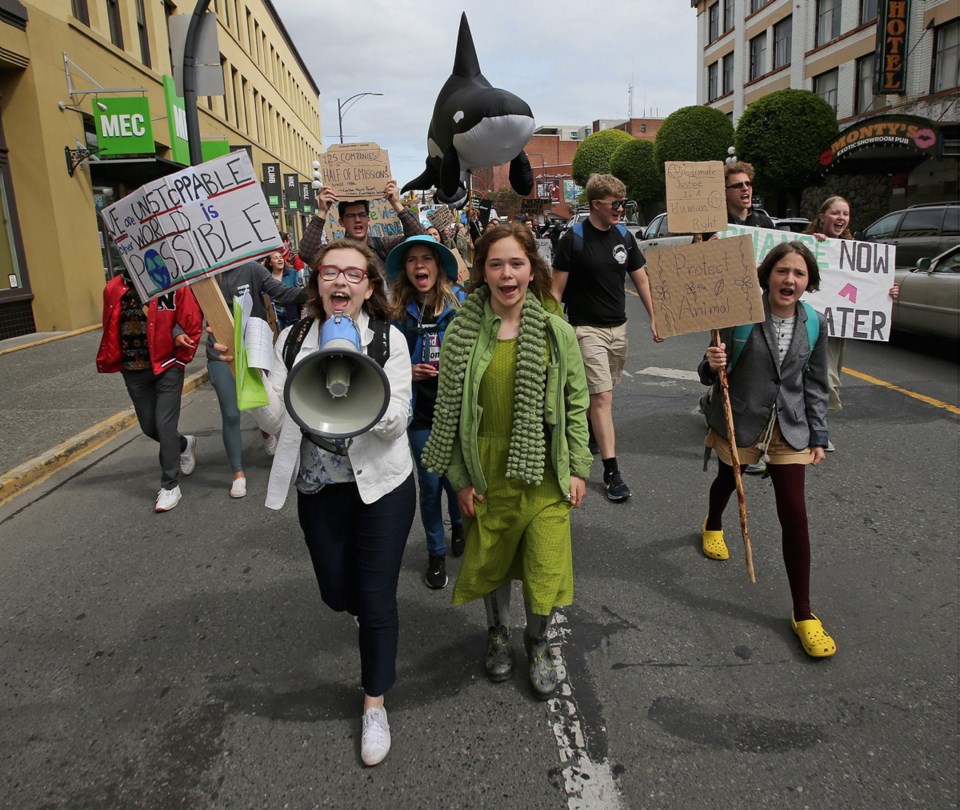Young climate activists say they’re motivated by feelings of eco-anxiety to organize strikes and demand government action.
A climate strike is scheduled for Greater Victoria on Friday, Sept. 27, 2019, with walkouts beginning at 11 a.m., and a rally at noon at the legislature.
Emma-Jane Burian, a 17-year-old leader in the youth movement in Victoria, said she’s not alone in feeling depressed about the lack of action taken by government to address climate change.
“Kids are feeling depressed that we might die and there might not be people to save us,” Burian said. “Organizing helps combat that for me.”
Child psychologist Dr. Jillian Roberts said the “extremely common” feelings are something she sees every week in her practice. Roberts defined eco-anxiety as a constant worry about the future and a sense of panic and helplessness.
“Just not being able to stop their mind from being concerned about the world and what’s going to happen in the world,” she said.
While eco-anxiety isn’t an official diagnosis, Roberts said it has credibility within the psychology community.
She first started to notice the issue about 10 years ago after environmentalist and former U.S. vice-president Al Gore, who shared a Nobel Peace Prize in 2007 for his climate-change work, visited Victoria.
Feelings of eco-anxiety in young people have been increasing every year since, she said.
Rebecca Wolf-Gage, 13, a co-organizer of last Friday’s student strike on the legislature lawn, gets panic attacks when she thinks about climate change.
Twelve-year-old Cade Anderson, who also organized last Friday’s event, feels helpless, “like everything is getting faster,” when thinking about how the planet.
Like Burian, the two throw themselves into action when the feelings intensify.
“Organizing climate strikes is how I get more energy and how I say: ‘Wow I’m actually making a difference. Maybe we can stop this climate crisis,’ ” Rebecca said.
Cade — who is non-binary and uses the pronouns they, them and theirs — said, like other types of anxiety and depression, eco-anxiety is hard to see in other people.
According to Roberts, eco-anxiety can invoke the fight, flight or freeze response in children.
Fleeing looks like avoiding the subject altogether or trying to escape, she said.
Freezing is a “complete paralysis,” moving toward depression. These are passive responses that inspire feelings of helplessness.
Fighting, or taking action, “is a much healthier place for a young person to be to be — out there trying to make a difference,” Roberts said.
She recommends parents help children find ways to move toward action, from hopeless to hopeful.
Attending rallies is a good way to encourage kids to become more actively involved and show them they’re not alone. Roberts also recommends creating a climate plan at home to give kids a sense of agency and empowerment.
“What that does is fills the child with hope,” she said.
Almost 4,000 people in Canada have signed the No Future Pledge, agreeing not to have children unless governments take serious action on climate change.
Those agreeing not to have families despite a personal desire to have children are saying they don’t have hope for a healthy future.
Emma Lim, 18, started the movement, despite always wanting to be a mother.
“I am giving up my chance of having a family because I will only have children if I know I can keep them safe,” she writes on the pledge website. “I am not the only young person giving up lifelong dreams because they are unsure of what the future will hold.”
For Savannah Layne Barratt, who’s organizing the student walk-out at Camosun College today, signing the pledge feels too hopeless. “It’s something I’m thinking about,” she said.
“It’s a common thing to talk about today with your friends —whether you’re going to have kids, because you’re scared about what you’re giving them.
“You feel scared for your future.”
About today's climate strike
Walkouts for the climate strike will begin at 11 a.m., with participants gathering at the legislature at noon. A march will follow.
Several businesses are closing for the strikes or allowing their staff to attend.
The global climate strikes are inspired by Swedish 16-year-old climate activist Greta Thunberg, who started #FridaysForFuture to protest outside the Swedish Parliament. She has since encouraged youth around the world to also strike.
Eight Victoria-area churches will ring their bells around midday to coincide with the global climate strike.
The bells will sound for 11 minutes, one for each of the years the planet has to take action to prevent irreversible damage. The 11-year estimate is cited in a United Nations report.
First Met United, Oak Bay United, St. Andrew’s Roman Catholic, First Unitarian, St. Paul’s United Sidney, St. Andrew’s Presbyterian and St. Mary’s Anglican Metchosin are ringing their bells starting at noon today. St. John the Divine Anglican will ring their bells starting at 11 a.m., which they’ve been doing since Monday.



